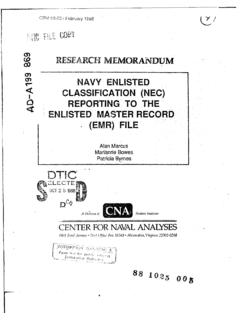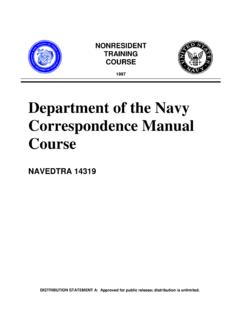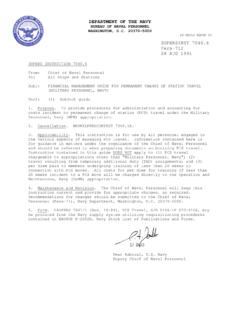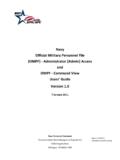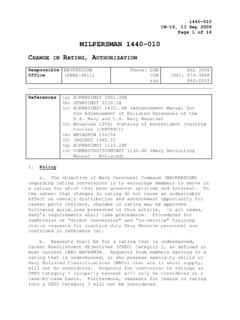Transcription of Navy Electricity and Electronics Training Series
1 UNCLASSIFIED. NONRESIDENT. Training . COURSE. May 2013. navy Electricity and Electronics Training Series Module 4 Electrical Conductors, Wiring Techniques, and Schematic Reading NAVEDTRA 14176A. S/N 0504LP1122345. Notice: NETPDTC is no longer responsible for the content accuracy of the NRTCs. For content issues, contact the servicing Center of Excellence: Center for Surface Combat Systems; (540) 284- 1061 or DSN: 234. For course registration, issues, or login issues contact the NRTC Helpdesk at: 1-877-264-8583 DSN: 922-1511 or Email: DISTRIBUTION STATEMENT A: Approved for public release;. distribution is unlimited. UNCLASSIFIED. UNCLASSIFIED. Although the words he, him, and his are used sparingly in this course to enhance communication, they are not intended to be gender driven or to affront or discriminate against anyone. DISTRIBUTION STATEMENT A: Approved for public release; distribution is unlimited. UNCLASSIFIED. UNCLASSIFIED.
2 PREFACE. By enrolling in this self-study course, you have demonstrated a desire to improve yourself and the navy . Remember, however, this self-study course is only one part of the total navy Training program. Practical experience, schools, selected reading, and your desire to succeed are also necessary to successfully round out a fully meaningful Training program. THE COURSE: This self-study course is organized into subject matter areas, each containing learning objectives to help you determine what you should learn along with text and illustrations to help you understand the information. The subject matter reflects day-to-day requirements and experiences of personnel in the rating or skill area. It also reflects guidance provided by Enlisted Community Managers (ECMs) and other senior personnel, technical references, instructions, etc., and either the occupational or naval standards, which are listed in the Manual of navy Enlisted Manpower Personnel Classifications and Occupational Standards, NAVPERS 18068.
3 THE QUESTIONS: The questions that appear in this course are designed to help you understand the material in the text. VALUE: In completing this course, you will improve your military and professional knowledge. Importantly, it can also help you study for the navy -wide advancement in rate examination. If you are studying and discover a reference in the text to another publication for further information, look it up. 2013 Edition Published by Center for Surface Combat Systems (CSCS). NAVSUP Logistics Tracking Number 0504-LP-112-2345. i UNCLASSIFIED. UNCLASSIFIED. Sailor's Creed I am a United States Sailor. I will support and defend the Constitution of the United States of America and I will obey the orders of those appointed over me. I represent the fighting spirit of the navy and those who have gone before me to defend freedom and democracy around the world. I proudly serve my country's navy combat team with honor, courage and commitment.
4 I am committed to excellence and the fair treatment of all.. ii UNCLASSIFIED. UNCLASSIFIED. TABLE OF CONTENTS. CHAPTER PAGE. 1 Electrical 1-1. 2 Wiring Techniques .. 2-1. 3 Schematic 3-1. APPENDIX. A A-1. B Electrical and Electronic B-1. C References .. C-1. Course Assignments follow Appendix C. iii UNCLASSIFIED. UNCLASSIFIED. navy Electricity AND Electronics Training . Series . The navy Electricity and Electronics Training Series (NEETS) was developed for use by personnel in many electrical and electronic-related navy ratings. Written by, and with the advice of, senior technicians in these ratings, this Series provides beginners with fundamental electrical and electronic concepts through self-study. The presentation of this Series is not oriented to any specific rating structure, but is divided into modules containing related information organized into traditional paths of instruction. The Series is designed to give small amounts of information that can be easily digested before advancing further into the more complex material.
5 For a student just becoming acquainted with Electricity or Electronics , it is highly recommended that the modules be studied in their suggested sequence. Considerable emphasis has been placed on illustrations to provide a maximum amount of information. In some instances, knowledge of basic algebra may be required. Course descriptions and ordering information may be found at then click on the Programs tab, then select the Nonresident Training Courses from the list. Throughout the text of this course and while using technical manuals associated with the equipment you will be working on, you will find the below notations at the end of some paragraphs. The notations are used to emphasize that safety hazards exist and care must be taken or observed. WARNING. AN OPERATING PROCEDURE, PRACTICE, OR CONDITION, ETC., WHICH MAY. RESULT IN INJURY OR DEATH IF NOT CAREFULLY OBSERVED OR. FOLLOWED. CAUTION. AN OPERATING PROCEDURE, PRACTICE, OR CONDITION, ETC.
6 , WHICH MAY. RESULT IN DAMAGE TO EQUIPMENT IF NOT CAREFULLY OBSERVED OR. FOLLOWED. NOTE. An operating procedure, practice, or condition, etc., which is essential to emphasize. iv UNCLASSIFIED. UNCLASSIFIED. STUDENT FEEDBACK AND QUESTIONS. We value your suggestions, questions, and criticisms on our courses. If you would like to communicate with us regarding this course, we encourage you, if possible, to use e-mail or to post your comments on the Community of Practice (COP) page located at If you write or fax, please use a copy of the Student Comment form that follows this page. For subject matter questions: E-mail: Phone: Comm: 540-284-1061. DSN: 234-4639. Address: COMMANDING OFFICER. Center for Surface Combat Systems 5395 First St Dahlgren, VA 22448-5200. v UNCLASSIFIED. UNCLASSIFIED. Student Comments Course Title: NEETS Module 4-Electrical Conductors, Wiring Techniques, and Schematic Reading NAVEDTRA: 14176A Date: _____. We need some information about you: Rate/Rank and Name: _____ Command/Unit: _____.
7 Street Address: _____ City: _____ State/FPO: _____ Zip _____. Your comments, suggestions, etc.: Privacy Act Statement: Under authority of Title 5, USC 301, information regarding your military status is requested in processing your comments and in preparing a reply. This information will not be divulged without written authorization to anyone other than those within DOD for official use in determining performance. vi UNCLASSIFIED. UNCLASSIFIED. This page left intentionally blank. vii UNCLASSIFIED. Module 4-Electrical Conductors, Wiring Techniques, and Schematic Reading UNCLASSIFIED. 1 ELECTRICAL CONDUCTORS. LEARNING OBJECTIVES. Upon completing this chapter, you should be able to: 1. Recall the definitions of unit size, mil-foot, square mil, and circular mil and the mathematical equations and calculations for each. 2. Define specific resistance and recall the three factors used to calculate it in ohms. 3. Describe the proper use of the American Wire Gauge when making wire measurements.
8 4. Recall the factors required in selecting proper size wire. 5. State the advantages and disadvantages of copper or aluminum as conductors. 6. Define insulation resistance and dielectric strength including how the dielectric strength of an insulator is determined. 7. Identify the safety precautions to be taken when working with insulating materials. 8. Recall the most common insulators used for extremely high voltages. 9. State the type of conductor protection normally used for shipboard wiring. 10. Recall the design and use of coaxial cable. INTRODUCTION TO ELECTRICAL CONDUCTORS. In the previous modules of this Training Series , you have learned about various circuit components. These components provide the majority of the operating characteristics of any electrical circuit. They are useless, however, if they are not connected together. Conductors are the means used to tie these components together. Many factors determine the type of electrical conductor used to connect components.
9 Some of these factors are the physical size of the conductor, its composition, and its electrical characteristics. Other factors that can determine the choice of a conductor are the weight, the cost, and the environment where the conductor will be used. 1-1. UNCLASSIFIED. Module 4-Electrical Conductors, Wiring Techniques, and Schematic Reading UNCLASSIFIED. CONDUCTOR SIZES. To compare the resistance and size of one conductor with that of another, we need to establish a standard or unit size. A convenient unit of measurement of the diameter of a conductor is the mil ( , or one-thousandth of an inch). A convenient unit of conductor length is the foot. The standard unit of size in most cases is the MIL-FOOT. A. wire will have a unit size if it has a diameter of 1 mil and a length of 1 foot. Square Mil The square mil is a unit of measurement used to determine the cross-sectional area of a square or rectangular conductor (views A and B of figure 1-1).
10 A square mil is defined as the area of a square, the sides of which are each 1 mil. To obtain the cross-sectional area of a square conductor, multiply the dimension of any side of the square by itself. For example, assume that you have a square conductor with a side dimension of 3 mils. Multiply 3 mils by itself (3 mils 3 mils). This gives you a cross-sectional area of 9. square mils. Figure 1-1 Cross-sectional areas of conductors 1-2. UNCLASSIFIED. Module 4-Electrical Conductors, Wiring Techniques, and Schematic Reading UNCLASSIFIED. Q1. State the reason for the establishment of a "unit size" for conductors. Q2. Calculate the diameter in MILS of a conductor that has a diameter of inch. Q3. Define a mil-foot. To determine the cross-sectional area of a rectangular conductor, multiply the length times the width of the end face of the conductor (side is expressed in mils). For example, assume that one side of the rectangular cross-sectional area is 6 mils and the other side is 3 mils.
